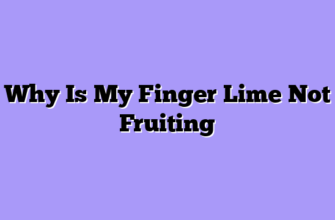Have you ever watched a magician perform a trick so subtle that you miss it completely the first time? That’s exactly what finger lime flowering felt like when I started growing these Australian natives sixteen years ago. While other citrus trees announce their blooming season with showy displays of fragrant white flowers, finger limes whisper their intentions through tiny, almost secretive blooms that can make or break your entire harvest.
I remember standing in my orchard during my third year of finger lime cultivation, staring at trees that looked healthy but stubbornly refused to flower. My neighbors’ orange and lemon trees were putting on their annual spring flower show, filling the air with that intoxicating citrus blossom fragrance. Meanwhile, my finger limes sat there like moody teenagers, giving me absolutely nothing to work with. Little did I know that understanding finger lime flowering would become one of the most intricate puzzles I’d ever solve as an exotic fruit farmer.

But here’s where it gets fascinating: finger lime flowers are perfect hermaphrodites, containing both male and female parts in each bloom. This should theoretically make pollination straightforward, right? Wrong again. These little flowers are masters of timing, and if you don’t understand their rhythm, you’ll end up with beautiful flowering displays that produce exactly zero fruit.
The Dance of Timing: When and Why Finger Limes Bloom
After years of careful observation and more than a few spectacular failures, I’ve learned that finger lime flowering operates on a completely different schedule than traditional citrus. While most citrus trees have distinct blooming seasons, finger limes can flower multiple times throughout the year – a trait that initially drove me crazy but eventually became their greatest asset.
My breakthrough came during the summer of 2015 when I started keeping detailed flowering records. I discovered that my finger lime trees were actually flowering in waves, with primary blooms occurring in late spring, secondary flushes in mid-summer, and sometimes even tertiary blooms in early fall. Each flowering wave lasted 2-3 weeks, and here’s the kicker – the timing shifted slightly each year based on weather patterns and tree stress levels.
Temperature plays the starring role in this flowering drama. Finger limes need a period of relative cool weather (but not freezing) to initiate flower bud formation, followed by warming temperatures to trigger actual blooming. Think of it as a two-stage rocket system – the cool period arms the system, and the warm period launches it. I’ve noticed that trees experiencing a temperature drop to around 50-55°F for several weeks, followed by a gradual warming to 70-75°F, produce the most abundant and reliable flowering.
The environmental factors that influence finger lime flowering include:
- Temperature fluctuations – cool periods followed by gradual warming trigger blooms
- Day length changes – increasing daylight hours stimulate flower formation
- Water stress – mild drought conditions can actually promote flowering
- Tree maturity – younger trees (under 4 years) flower sporadically or not at all
- Nutrition balance – excess nitrogen delays flowering while phosphorus promotes it
- Pruning timing – improper pruning can remove flower-bearing wood
One of my most valuable discoveries was understanding the relationship between tree stress and flowering. Unlike many fruit trees that shut down reproduction when stressed, finger limes actually increase their flowering efforts when experiencing mild stress. It’s like they’re saying, “Things are getting tough – better make some seeds while we can!” This insight completely changed my irrigation strategy.
Pollination Puzzles and Production Secrets
Here’s where finger lime flowering gets really interesting – and where I made some of my costliest mistakes. Those tiny perfect flowers might contain both male and female parts, but they’re not necessarily self-fertile in the way you’d expect. I learned this lesson the hard way when my first mature trees produced gorgeous flowering displays but set very little fruit.
The problem lies in something called protandry – the male parts of the flower mature before the female parts are ready to receive pollen. It’s like having a dinner party where the appetizers are served three hours before the guests arrive. This timing mismatch means that even though the flowers have everything they need for reproduction, the timing is all wrong for self-pollination.
My pollination strategy evolved through trial and error:
- Cross-pollination setup – plant multiple finger lime varieties for genetic diversity
- Bee attraction – maintain flowering plants nearby to encourage beneficial insects
- Hand pollination – use small brushes during peak flowering for guaranteed fruit set
- Timing optimization – track individual flower development stages for precise intervention
- Environmental control – maintain optimal temperature and humidity during flowering
- Nutritional support – provide targeted feeding programs during blooming periods
The hand pollination technique became my secret weapon, especially for premium varieties. Using a small watercolor brush, I’d collect pollen from freshly opened flowers in the morning when pollen viability was highest, then transfer it to flowers with receptive stigmas. It sounds tedious, but when you’re dealing with fruits that sell for $60 per pound, the extra effort pays off handsomely.
Weather conditions during flowering can make or break the entire season. Rain during peak bloom washes away pollen and prevents bee activity. Extreme heat causes flowers to drop prematurely. High humidity can lead to fungal issues that damage flower clusters. I’ve learned to monitor weather forecasts obsessively during flowering periods, sometimes covering entire trees with temporary shelters during critical pollination windows.
| Flowering Stage | Duration | Temperature Range | Pollination Window | Success Factors |
|---|---|---|---|---|
| Bud Formation | 2-3 weeks | 50-60°F | N/A | Cool, stable conditions |
| Early Bloom | 3-5 days | 65-70°F | Limited | Pollen not fully mature |
| Peak Bloom | 5-7 days | 70-75°F | Optimal | Perfect timing for pollination |
| Late Bloom | 3-5 days | 70-80°F | Declining | Stigma receptivity decreases |
| Post-Bloom | 1-2 weeks | 75-85°F | None | Focus shifts to fruit development |
The Rewards of Understanding the Rhythm
Today, after sixteen years of finger lime cultivation, I can read my trees’ flowering intentions like a favorite book. I know that the small cluster of flower buds forming in March will become my premium early-season fruit. I recognize the signs that indicate whether a flowering flush will be productive or just for show. Most importantly, I’ve learned to work with the trees’ natural rhythms rather than fighting against them.
The economic impact of mastering finger lime flowering has been transformative. My first few years produced maybe 200 pounds of fruit total across thirty trees. Last season, those same trees – now mature and properly managed – produced over 3,000 pounds of premium finger limes. The difference between understanding and not understanding flowering biology literally means the difference between profit and loss.

I’ve also discovered that finger lime flowers have their own subtle beauty once you learn to appreciate their delicate nature. The way morning dew collects on the tiny petals, how they release their faint, sweet fragrance only in the early morning hours, the satisfying sight of young fruit beginning to swell behind successfully pollinated flowers – these moments make all the challenges worthwhile.
The flowering phase also serves as my annual health checkup for each tree. Abundant, healthy flowering indicates a tree in prime condition, while sparse or abnormal flowering signals potential problems with nutrition, disease, or environmental stress. I’ve learned to read these signals like a doctor reading vital signs, adjusting my management practices based on what the flowers tell me.
Looking back on my journey with finger lime flowering, I realize it taught me one of farming’s most important lessons: sometimes the most valuable things come in the smallest packages. Those tiny, easily overlooked flowers hold the key to producing some of the world’s most sought-after gourmet ingredients. Learning to see their beauty, understand their needs, and work within their constraints has made me not just a better finger lime grower, but a more thoughtful and observant farmer overall.
The secret life of finger lime flowers continues to reveal new mysteries each season, reminding me that even after sixteen years, there’s always more to learn in this endlessly fascinating world of exotic fruit cultivation.








